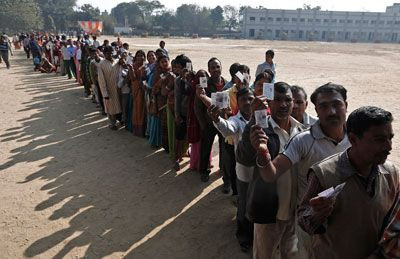A Preview of India's 2014 Election: How Will 800 Million People Choose Their Next Leader?

India will embark Monday on the biggest democratic election in global history with some 815 million eligible voters, more than all the people in the U.S., Russia, Japan and Nigeria combined, casting ballots in a six-week process to elect a prime minister.
It's a logistics tour de force: Voting will occur at 930,000 polling stations across India from April 7 to May 12.
It's also more complex than an election in a direct democracy. Rather, based on the British parliamentary system, Indians vote for 543 legislators who then appoint a prime minister from the party that amasses a majority of seats in the lower house of parliament, where each state in India has proportional representation, as in the U.S. House of Representatives.
The independent Election Commission of India will count votes and announce results on May 16. If no one party has amassed a simple majority in parliament on that date, parties will have only a few weeks of frantic negotiations in which to form alliances and name a new prime minister.
Most observers expect such negotiations because there are so many political parties in India and the population is so diverse it is often difficult for one party -- even a dominant force like the center-left Congress Party or the center-right Bharatiya Janata Party (BJP) -- to get a majority in the lower house of parliament. Because of that difficulty, what normally happens is coalitions are formed and behind-the-scenes deals are cut in order to pick a leader. The process also tends to lead to policy changes because the participation of smaller parties tend to dilute or moderate some of the policy measures proposed by the larger party seeking support.
In the current election, polls suggest that BJP and its allies will win the most seats in the lower house, but fail to gain an outright majority. Consequently, Narendra Modi, the leader of the BJP, and his top associates will be compelled to enter into delicate negotiations with smaller regional parties and offer concessions in exchange for their support. Such concessions might include cabinet ministry positions for senior members of the regional parties.
Reports in Indian media suggest that the BJP may seek to acquire the support of The All India Trinamool Congress, a regional party that governs the northeastern state of West Bengal, by offering Trinamool chief Mamata Banerjee a cabinet position in the next government or by providing financial assistance to debt-stricken West Bengal. Trinamool is itself expected to win about 30 or 35 lower house seats in the current election, which might be enough to give BJP a simple majority in parliament.
Here's another wrinkle that is unique to Indian politics: Even if the BJP wins the election and gains a majority of seats in parliament after creating coalitions, it is not even guaranteed that Modi will become prime minister. Indeed, if coalition partners demand the top job for one of their senior members in exchange for support, Modi could conceivably have to relinquish his dream of becoming prime minister. This is an unlikely outcome, but not entirely out of the realm of possibility.
The previous Indian government, led by Congress and Prime Minister Manmohan Singh, also was comprised a coalition of several parties, calling itself the United Progressive Alliance and ruled the country for 10 years.
© Copyright IBTimes 2024. All rights reserved.





















